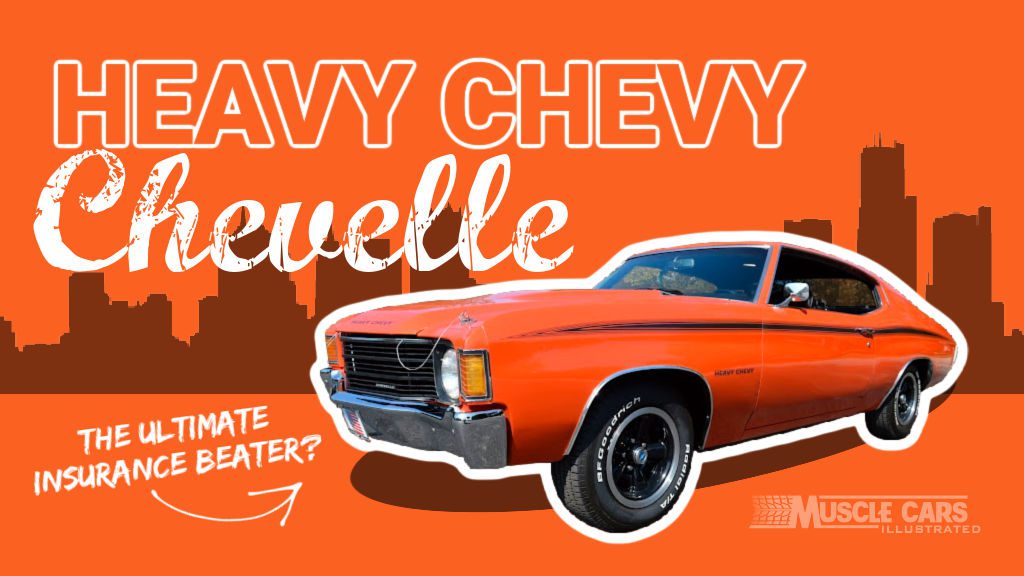
The Chevelle was a versatile car line produced by Chevrolet, offering everything from station wagons to sporty coupes. However, in 1971, Chevrolet introduced a new addition to the Chevelle line: the Heavy Chevy, an affordable entry-level performance car.
The Heavy Chevy was a two-year-only package designed specifically for young buyers who wanted a hot car at an economical price. Loaded with graphics and styling cues, this package targeted unmarried 20-somethings seeking a performance machine that would be cheap to maintain and insure.
Many considered the Heavy Chevy the ultimate insurance beater, as it offered the sporty good looks and performance of the Chevy Chevelle SS without the high insurance premiums.
Table of Contents
What is a Heavy Chevy?
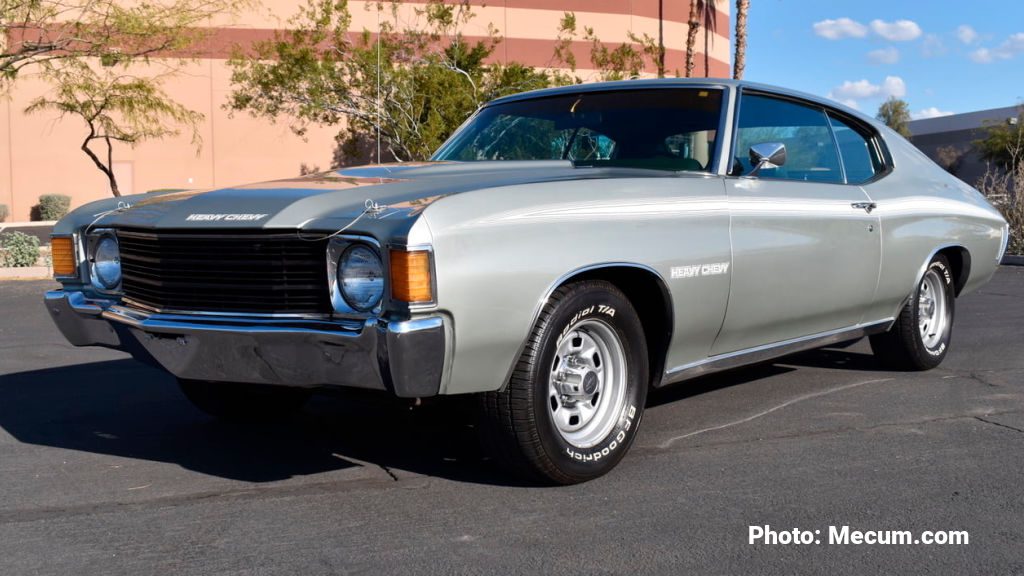
The Heavy Chevy was a stripped-down Chevelle that sported the same domed hood as an SS and most of the same engines—except for the mighty Chevy 454 engine—and wasn’t a supercar, according to insurance agents. Owners of the Heavy Chevy could dodge higher premiums because the insurance companies based insurance premiums, in part, on the model of the vehicle, not its engine.
Given the Super Sport model had an established history that triggered raised eyebrows among the insurance companies in a way the new 1971 Heavy Chevy did not. Available from 1971-1972, Chevrolet produced 16,235 hardtops—just 37% of the SS production (44,239 units). While it didn’t outsell the SS, it left an indelible mark on muscle car history.
Heavy Chevy Highlights
| Aspect | Description |
|---|---|
| Heavy Chevy Chevelle | The 1971-1972 Chevrolet Chevelle, nicknamed “Heavy Chevy,” is a popular muscle car known for its distinctive design, powerful engines, and impressive performance, making it a favorite among car enthusiasts. |
| Design Evolution | The 1971-1972 Chevelle underwent design changes, including a new front-end look with a single-headlight design, a revised rear end, and more curved body lines, giving it a fresh and distinctive appearance. |
| Performance-Focused Models | The Chevelle was available in various performance-focused models, such as the SS 454, Malibu, and the “Heavy Chevy” package, offering unique features and enhancements to suit various preferences. |
| Engine Options | The 1971-1972 Chevelle had several engine options, including the powerful 402 cubic inch V8, delivering impressive horsepower and torque to satisfy performance enthusiasts. |
| Transmission Choices | Buyers chose manual and automatic transmissions, catering to different driving styles and preferences, ensuring a versatile driving experience for Chevelle enthusiasts. |
| Distinctive Features | The “Heavy Chevy” package featured unique decals, a blacked-out grille, Rally wheels, and special badging, which set it apart from other Chevelle models and made it stand out on the road. |
| Affordability | The 1971-1972 Chevelle, particularly the “Heavy Chevy” package, was designed to be more affordable than other high-performance muscle cars of the era, making it an attractive option for those seeking power without breaking the bank. |
Heavy Chevy vs. SS: What’s the Difference?
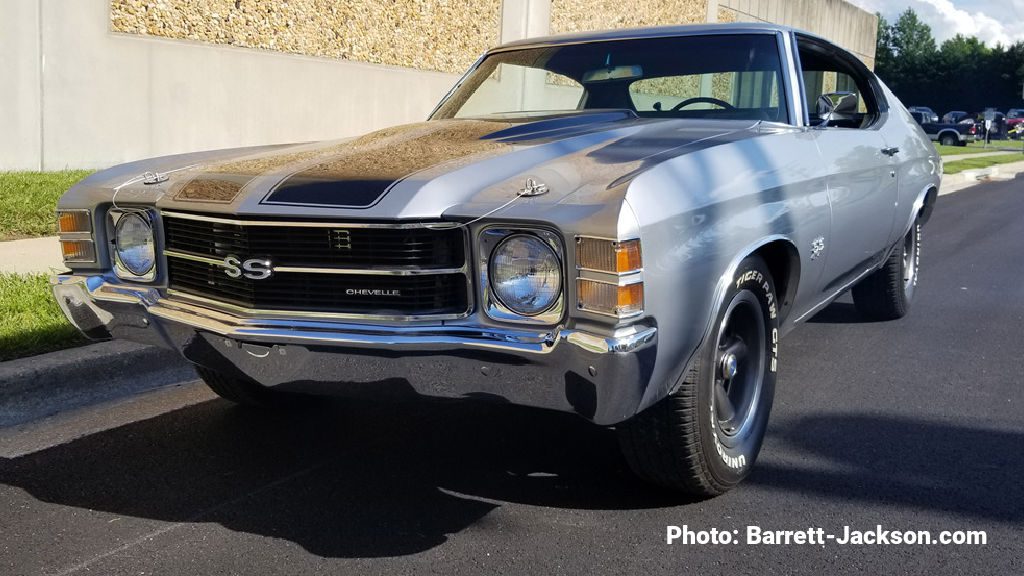
The SS (Super Sport) Chevelle was a high-performance version of the Chevelle, while the Heavy Chevy (YF3) was a separate options package. The SS came with additional performance features, such as a powerful 454 cubic inch V-8 engine and improved suspension, which made it more suitable for drag racing.
On the other hand, the Heavy Chevy was marketed as a more affordable muscle car, offering many of the performance features of the SS at a lower price point. The Heavy Chevy was available with several engines, including several V-8 options, and had exterior and interior upgrades compared to the standard Chevelle models.
The main difference between the SS and Heavy Chevy was the performance and the price, with the SS being the more expensive, high-performance option and the Heavy Chevy being the more budget-friendly alternative.
| Heavy Chevy | Super Sport | |
| Domed Cowl Hood | Yes | Yes |
| Bucket Seats | No | Yes |
| Hood Pins | Yes | Yes |
| 454 cubic inch engine | No | Yes |
| Hood / Decklid Stripes | No | Yes |
| Rally Wheels | Yes | No |
| Side Stripes | Yes | No |
1971 Heavy Chevy

The 1971 Heavy Chevy was an option package offered by Chevrolet for the Chevelle in that year. It was designed to provide a more powerful and aggressive-looking car than the standard Chevelle. 6,727 Heavy Chevys were sold in 1971 in the U.S. due to a lack of promotion by the manufacturer. Chevrolet left it up to the dealers to promote the vehicle locally.
Engine Options

Heavy Chevy buyers had four V-8 engines to choose from in 1971. The Turbo-Fire 307 was equipped with a two-barrel carburetor, while the Turbo-Fire 350 was available with either a two- or four-barrel carburetor. The Turbo-Jet 400, a 402 big-block Chevrolet engine (formerly the 396), was also available. The top-of-the-line LS5 454 engine was reserved for the SS.
307cid
| Displacement | 307 V-8 |
| Horsepower | 140 @ 2,400 RPM |
| Torque | 300 lb-ft @ 2,800 RPM |
| Carburetor | 2bbl |
350cid
| Displacement | 350 V-8 |
| Horsepower | 245 @ 4,800 RPM |
| Torque | 165 lb-ft @ 4,800 RPM |
| Carburetor | 2bbl |
350cid
| Displacement | 350 V-8 |
| Horsepower | 270 @ 4,400 RPM |
| Torque | 300 lb-ft @ 2,800 RPM |
| Carburetor | 4bbl |
402cid
| Displacement | 402 V-8 |
| Horsepower | 300 @ 4,800 RPM |
| Torque | 260 lb-ft @ 4,400 RPM |
| Carburetor | 4bbl |
Appearance
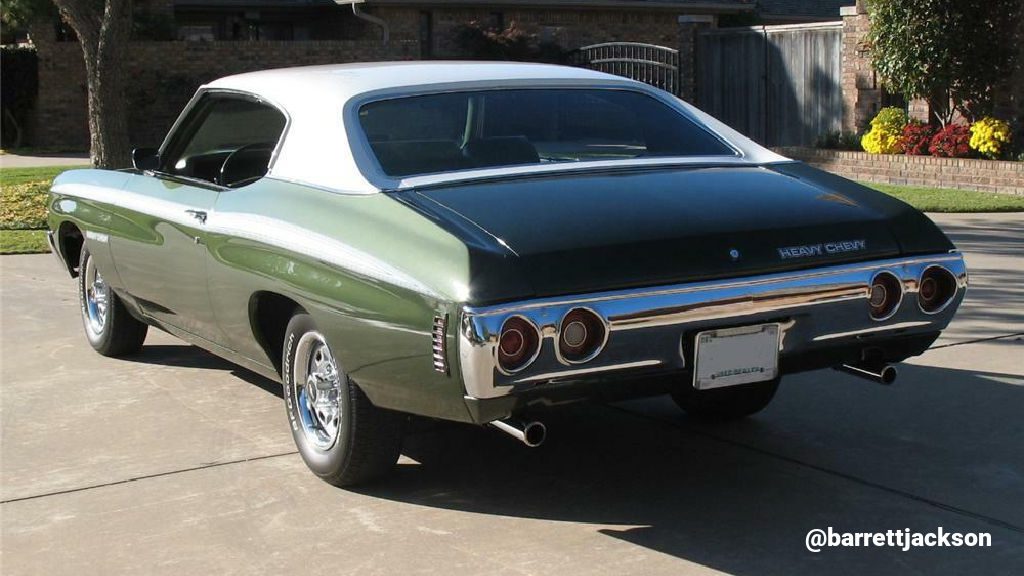
The 1971 Heavy Chevy package (YF3) included several appearance upgrades for the Chevelle. The YF3 package added Heavy Chevy decals, a blacked-out grille, side stripes, a cowl hood, and 14×6 Rally wheels. Only two colors were available for the striping and emblems: white and black.
The grille was blacked out and did not include the Chevy Bowtie emblem. However, this model did receive the chrome grille outline molding that the standard Chevelle did not. Also absent was the bright trim molding around the wheels, rocker, and roof drip rails. These features made the Heavy Chevy a more sporty vehicle, appealing to those who wanted a muscle car that was both stylish and fast.
Heavy Chevy Paint Colors
- Tuxedo Black
- Mulsamme Blue
- Ascot Blue
- Classic Copper
- Placer Gold
- Lime Green
- Cottonwood Green
- Antique Green
- Burnt Orange
- Cranberry Red
- Metallic Rosewood
- Sandalwood
- Nevada Silver
- Antique White
- Sunflower Yellow
Two-tone paint options were also available, with an antique white painted top.
- Mulsanne Blue
- Placer Gold
- Antique Green
- Lime Green
- Burnt Orange
- Sandalwood
Interior

The 1971 Heavy Chevy had a bench seat interior as the only option. The bench seat was vinyl with cloth inserts and came in black, dark blue, or dark jade. The interior was also equipped with other features, such as a vinyl-covered headliner, rubber-coated floor coverings, and door panels, all in matching colors.
The door panels were sparse, with no enhancements added for this model. They were color-coordinated with the interior and had raised panels with an ivory-white stripe. The dash came standard with the sweeping speedometer style with an optional clock. The round-style dash pods were an available option (RPO U14) that gave the interior an SS feel.
Overall, the bench seat interior of the 1971 Heavy Chevy was both functional and stylish, providing a comfortable ride for its occupants.
1971 Heavy Chevy Commercial
1972 Heavy Chevy
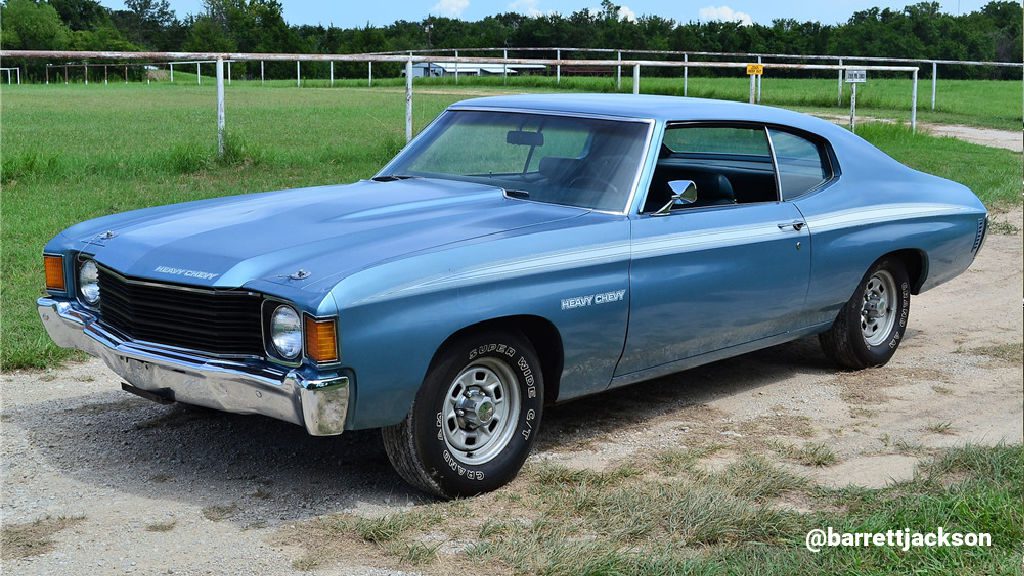
The 1972 Heavy Chevy was similar to the 1971 model but slightly different. It was equipped with the same engine options. However, the 1972 model received new exterior and interior features, including a revised grille and updated interiors with new upholstery patterns and colors. Chevrolet produced 9,508 in 1972, up from 6,727 in 1971.
Engine Options
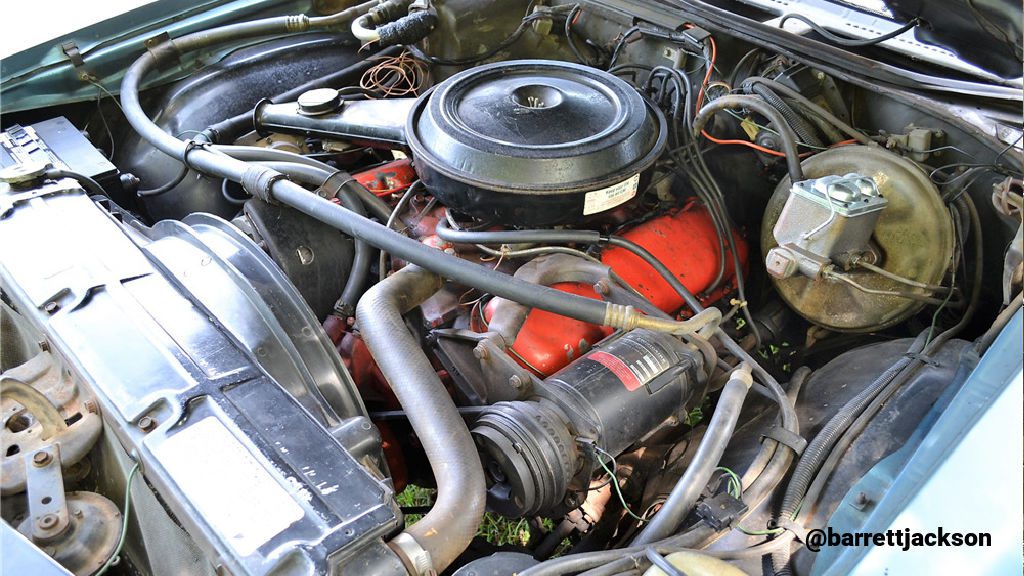
In 1972, the Heavy Chevy had the same engine options as in 1971. This included the Turbo-Fire 307 with a two-barrel carburetor, the Turbo-Fire 350 with either a two- or four-barrel carburetor, and the Turbo-Jet 400, a 402 big-block Chevrolet engine.
307cid
| Displacement | 307 V-8 |
| Horsepower | 130 @ 4,400 RPM |
| Torque | 230 lb-ft @ 2,400 RPM |
| Carburetor | 2bbl |
350cid
| Displacement | 350 V-8 |
| Horsepower | 165 @ 4,000 RPM |
| Torque | 280 lb-ft @ 2,400 RPM |
| Carburetor | 2bbl |
350cid
| Displacement | 350 V-8 |
| Horsepower | 175 @ 4,400 RPM |
| Torque | 280 lb-ft @ 2,400 RPM |
| Carburetor | 4bbl |
Turbo-Jet 400cid (402)
| Displacement | 402 V-8 |
| Horsepower | 240 @ 4,400 RPM |
| Torque | 345 lb-ft @ 3,200 RPM |
| Carburetor | 4bbl |
Appearance
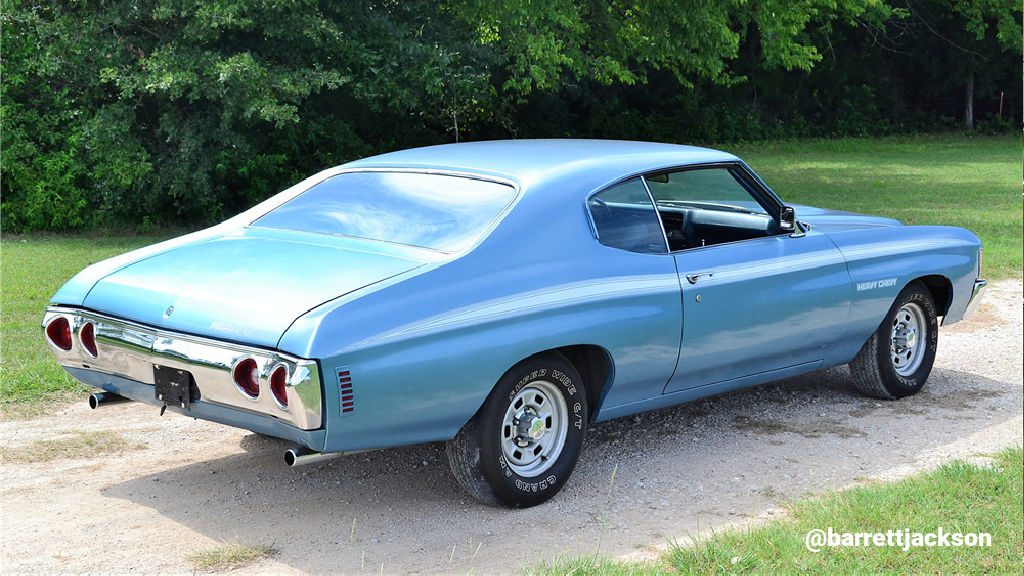
The exterior of the 1972 Hevy chevy was virtually the same as the 1971 model, including the hood, side stripes, decals, and 14×6 Rally wheels. The main visual differences are the same as any 1972 Chevelle, including the updated grille and side marker lamps on the vehicle’s front end. Otherwise, they’re indistinguishable from 1971.
Paint Colors
- Antique Whiteewter Silver
- Ascot Blue
- Mulsanne Blue
- Spring Green
- Gulf Green
- Sequoia Green
- Covert Tan
- Placer Gold
- Cream Yellow
- Golden Brown
- Mohave Gold
- Orange Flame
- Midnight Bronze
- Cranberry Red
There were also two-tone options available, with an antique white painted top.
- Mulsanne Blue
- Gulf Green
- Sequoia Green
- Golden Brown
- Mohave Gold
- Orange Flame
Interior
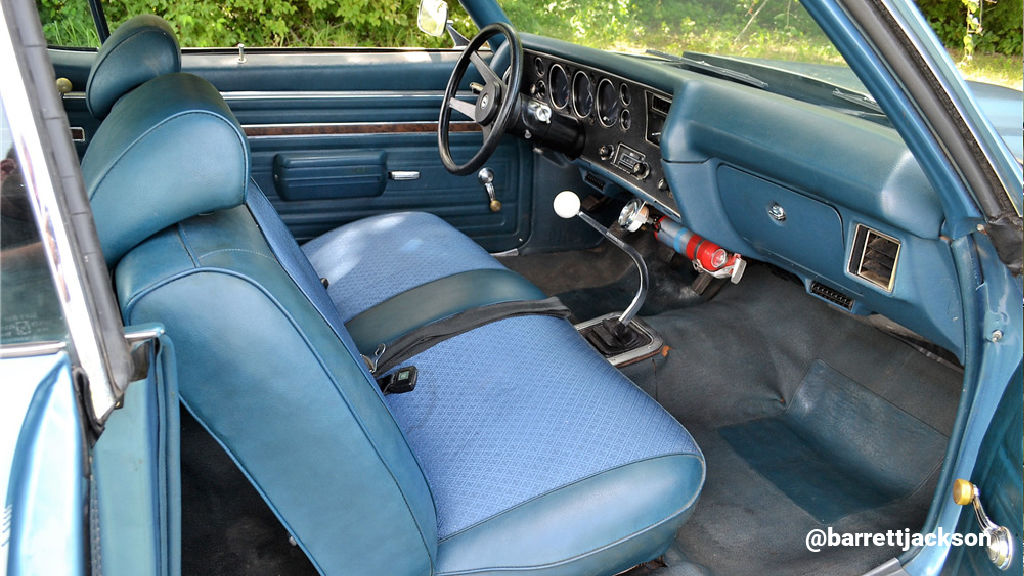
The bench seat interior of a 1972 Heavy Chevy offered a simple and functional design, focusing on comfort and versatility. The interior was almost unchanged from 1971, with a simulated wood trim strip on the door panels, instead of white, as the only quick way to distinguish between the two model years.
Conclusion
The Heavy Chevy was a special edition of the popular Chevrolet Chevelle produced in 1971 and 1972. It was designed for those looking for a V-8-powered Chevelle with a bold, aggressive look. It was a true insurance beater, allowing buyers to enjoy similar looks and performance to the SS Chevelle but without the higher insurance premiums. With its range of engine options, performance upgrades, and rarity, it is a vehicle worth considering for classic car enthusiasts and anyone who appreciates American muscle.
Take Our Poll!
"*" indicates required fields
Ryan
Ryan has owned muscle cars since 1986 and currently owns a 1972 Dodge Charger Rallye. He combines passion and experience to create engaging content for fellow muscle car enthusiasts. In 2018, he founded Muscle Cars Illustrated, authoring hundreds of articles on tips, history, and trends in the muscle car industry. He attends national car shows, auctions, and museums to stay current with the latest developments in the muscle car industry.Comments
Comments are closed.

The 72 had the SS type gauges.
My 71 Heavy Chevy had 350 2bbl. Saginaw 4 speed, Open rear axle no Posi , Single exhaust. Red with Black stripes, Black Vinyl Top, No Cowl hood, Gray grill, White interior
the thing you left out was 72 was the only year the vin number was on the engine block